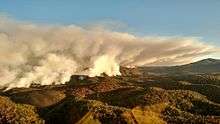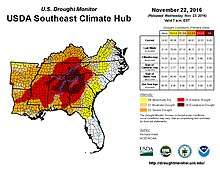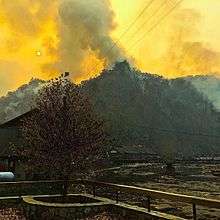2016 Southeastern United States wildfires
The 2016 Southeastern United States Wildfires were a series of wildfires in the Southeastern United States in October and November 2016. As of November 15, 2016, the U.S. Forest Service reported tracking 33 wildfires that had burned about 90,000 acres (36,000 ha).
| Southeastern United States wildfires of 2016 | |
|---|---|
 The Rough Ridge Fire burning in the Cohutta Wilderness | |
| Location | Alabama[1] Georgia North Carolina South Carolina Tennessee |
| Statistics | |
| Date(s) | October 23, 2016 – December 9, 2016 (EDT) |
| Burned area | At least 80,000 acres (32,000 ha) |
| Cause | Several fires suspected to have been caused by arson |
| Buildings destroyed | 400+[2] |
| Deaths | 14[3] |
| Non-fatal injuries | ~74[4] |
Context

Firefighters from 21 states[5] including Washington and Oregon were part of the effort to fight the blazes. North Carolina Governor Pat McCrory said 1600 firefighters fought 19 fires in his state, at a cost of $10 million since October 23. Arson is believed to be responsible for several fires in the Nantahala National Forest where 46,000 acres had burned as of November 18.[6][7] The Asheville Regional Airport reported no rain for ten days after October 8, 2016, after which the area was considered to be in severe drought,[8] while Cherokee, Clay and Macon Counties were considered to be in extreme drought. A month later these three counties and Graham and part of Swain were in exceptional drought, and ten other counties were in extreme drought. Only a trace of rain fell in the month ending November 15 and the airport reported a 10.8 inches (27 cm) deficit for the year 2016 as of November 18.[6][9][10]
As of December 8, even after rain, much of Georgia and Alabama continued to be in exceptional drought, while Tennessee and the western Carolinas were in extreme drought.[11]
Lightning and accidental human activity such as campfires may have started some fires. Poor air quality is an issue in Asheville and other parts of western North Carolina.[7]
Western North Carolina fires

The Tellico Fire in North Carolina began October 23 in Swain County, North Carolina and had burned over 5,600 hectares (14,000 acres) as of November 18, 2016. The Boteler Fire in Clay County, North Carolina began October 25 and had burned 3,600 hectares (8,900 acres) as of November 18.[10]
The Party Rock Fire in North Carolina, which McCrory called number two in the country, began November 5 and as of November 18 had burned 2,900 hectares (7,200 acres) and resulted in the evacuation of 1000 people in the areas of Bat Cave, Chimney Rock and Lake Lure.[6][12] People were allowed to return to Chimney Rock on November 21, 10 days after they left. Firefighters who came mostly from the eastern part of the state had watched buildings in the towns while local fire departments covered their areas. Lake Lure was the headquarters for operations.[13]
On November 30 a man was arrested for setting two Macon County fires.[14]
As of December 6, substantial rain had helped greatly in the effort to bring under control as many as 34 fires which had burned 60,000 acres.[14]
North Georgia fires
The Rough Ridge fire in the Cohutta Wilderness of Georgia, believed to have started from a lightning strike October 16, 2016,[15] had burned almost 11,300 hectares (28,000 acres) by November 20, making it one of the largest fires ever in Georgia. The Rock Mountain fire was about 4,250 hectares (10,500 acres) as of November 20, 2016 and caused the evacuation of Dream Catcher Cover north of Tate City.[16]
East Tennessee fires
On November 11, 2016, a Chattanooga man was arrested for setting three separate fires north and west of the city. Over 500 acres had been burned in connection with these fires.[17]
Governor Bill Haslam issued a burn ban for 51 counties starting on November 14 through December 15.[18]
On November 16, 2016, two men were arrested for arson in separate wildfire incidents in Tennessee. In Sequatchie County, an Alabama man admitted to dropping a cigarette in a pile of leaves, watching it burn and leaving without putting it out. In Monroe County, a resident was arrested for starting a burn on personal property, against the burn ban, that got out of control.[19]
As of November 17, 2016, Tennessee Division of Forestry reported 64 fires that had burned 17,734 acres. The largest was in Morgan County in the White Oak Circle area covered about 1900 acres but was contained. Another on Neddy Mountain in Cocke County had burned 1116 acres but was mostly contained.[20][21]
By November 21, just 95 acres were reported still burning in Tennessee, and at least half of the state's fires were reported to be started in connection with arson.[22]
On November 28, the Chimney Tops 2 fire in the Chimney Tops of the Great Smoky Mountains National Park spread with the aid of strong winds and dry conditions, the fire quickly broke into multiple fires and spread across the mountains above and around Gatlinburg, Tennessee. By the evening hours the fire had reached the downtown area of Gatlinburg, resulting in the evacuation of over 14,000 people, along with causing damage in and around the town.[23] By November 29, the wildfires had claimed at least three lives.[24] An additional four people were later confirmed dead the next day.[25] As of December 4, the Chimney Tops 2 fire had burned 17,006 acres.[14] A total of 14 people died and 134 others were injured in the Smoky Mountains fires, while over 2,400 structures were burned. Damages were totaled to over $500 Million.[14][26]
On December 8, the burn ban was lifted for four of the 51 counties in Tennessee to aid cleanup of tornadoes that happened on November 29 in southeast Tennessee.[27]
See also
References
- 33/40, ABC (2016-11-28). "Alabama Forestry Commission battling 20 active wildfires, windy conditions".CS1 maint: numeric names: authors list (link)
- "Wildfires scorch Gatlinburg, Pigeon Forge, destroying homes and businesses". The Globe & Mail. November 29, 2016. Retrieved November 29, 2016.
- Beam, Adam; Mattise, Jonathan (December 2, 2016). "RESIDENTS LINE UP TO SEE WILDFIRE-RAVAGED CITY; 13 DEAD". hosted.ap.org. AP.
- Hanna, Jason; Simon, Darran; Moshtaghian, Artemis (December 1, 2016). "Gatlinburg fires: 10 dead; families wait for news of missing". CNN. Retrieved December 1, 2016.
- Ball, Julie (November 15, 2016). "Updated: Party Rock fire grows to 3,400 acres". Asheville Citizen-Times. Retrieved November 16, 2016.
- Margulis, Abigail (November 19, 2016). "Dry air, gusty winds cause officials concern for fire growth". Asheville Citizen-Times. Retrieved November 21, 2016.
- Dorman, Travis (November 16, 2016). "West Coast crews mobilize to battle Southeast fires". USA Today. Retrieved November 16, 2016.
- "US Drought Monitor". DroughtMonitor.unl.edu. United States Drought Monitor. Retrieved December 2, 2016.
- Margulis, Abigail (October 20, 2016). "Asheville sees 10 days without rain, severe drought emerges". Asheville Citizen-Times. Retrieved November 21, 2016.
- Chávez, Karen (November 18, 2016). "Outbreak of WNC wildfires takes toll on wildlife, environment". Asheville Citizen-Times. Retrieved November 21, 2016.
- Martin, Jeff (December 8, 2016). "Drought, the South's unwelcome guest, stays despite rains". News & Observer. Associated Press. Retrieved December 9, 2016.
- Margulis, Abigail (November 16, 2016). "Rapid fire growth anticipated at Party Rock blaze". Asheville Citizen-Times. Retrieved November 16, 2016.
- Washburn, Mark (November 21, 2016). "Chimney Rock, NC mountain resort reopens after wildfire contained". News & Observer. Retrieved November 22, 2016.
- Chason, Rachel (December 6, 2016). "With rain's help, firefighters bring NC wildfires under control". News & Observer. Retrieved December 7, 2016.
- "Rough Ridge Fire". InciWeb. Retrieved November 17, 2016.
- Buchanan, Christopher (November 21, 2016). "North Ga. fires engulf 40,000 acres as battle, evacuations continue". WXIA. Retrieved November 21, 2016.
- "Archived copy". Archived from the original on 2016-12-01. Retrieved 2016-12-10.CS1 maint: archived copy as title (link)
- "Gov. Haslam issues burning ban for 51 Tennessee counties".
- "Two men charged with arson as crews make progress quelling 3 area blazes".
- Hara, Amanda (November 18, 2016). "Wildfires currently burning in East Tennessee". WVLT. Retrieved November 18, 2016.
- Hickman, Hayes; Dorman, Travis (November 18, 2016). "Blount County fire could burn up to 200 acres, officials say". Knoxville News-Sentinel. Retrieved November 18, 2016.
- "Haslam vows pursuit of Tennessee wildfire arsonists".
- Vellucci, Amy J.; Satterfield, Jamie (November 29, 2016). "14,000 evacuated from Gatlinburg; fires still burning". knoxnews.com. Retrieved November 29, 2016.
- "Gatlinburg wildfires claim 3 lives". WHIO-TV via Associated Press. November 29, 2016. Retrieved November 29, 2016.
- Hanna, Jason; Moshtaghian, Artemis; Blau, Max (November 30, 2016). "Gatlinburg fires: Death toll rises to 7". CNN. Retrieved November 30, 2016.
- "Confirmed victims of Smoky Mountain wildfires", WBIR, 30 Jan 2017. The 14th and last confirmed victim was identified 27 Jan 2017.
- "Burn ban lifted in 3 Tennessee counties". Archived from the original on 2016-12-09.